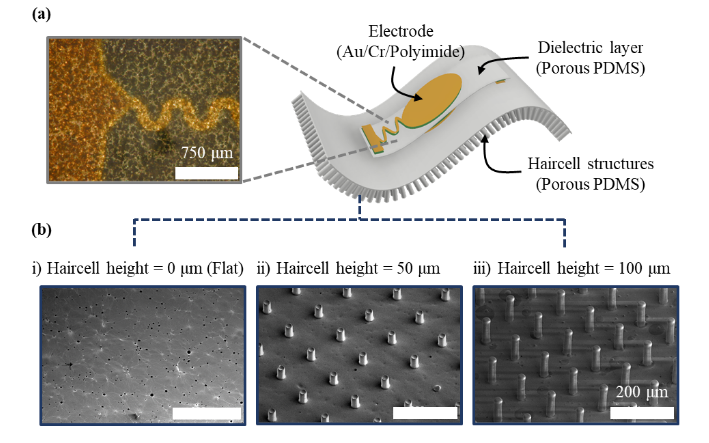Prof. Young-Ho Cho’s group at KAIST has taken a major step toward a skin-attachable pulsewave sensor capable of not only removing sweat rapidly from the beneath skin in real time but also increasing the pulsewave- signal- to- noise ratio. The results could be revolutionary in the effort to realize daily wearable and highly sensitive skin-attachable devices for long-term use without irritating the skin. The study was published on July 27 in Nanoscale Advances (A Porous PDMS Pulsewave Sensor with Haircell Structures for Water Vapor Transmission Rate and Signal-to-Noise Ratio Enhancement, Nanoscale Advances, 2021, 3, 4843).
“Wearable biosensors are becoming more attractive for the daily monitoring of physiological signals appearing on the skin, such as the body temperature, heart rate, and electrodermal activity,” Professor Cho explained. “Currently available skin-attachable sensors, however, are known to irritate the skin and have low sensing accuracy. Thus scientists are looking for ways to resolve these problems.”
Conventional polymer-based pulsewave sensors can cause contact dermatitis and itchiness during their long-term use because the sweat permeability with these devices is lower than the daily skin sweat rate (432 g/m2). They are also associated with low detection accuracy due to their low contact area and unstable contact with the skin.
Researchers have attempted to fabricate breathable materials by mixing polydimethylsiloxane (PDMS) with particles, such as sugars or salts, and removing the particles to leave pores in their place. Another technique for porous material fabrication uses gas to form pores in the material. These techniques have the disadvantages of expensive and/or complex processes, leaving pores of different sizes, and creating a non-uniform distribution of pores. In addition, previous porous materials are linked to low skin contact area and low sensing accuracy issues.
A team of researchers led by Professor Cho from the KAIST Department of Bio and Brain Engineering has succeeded in fabricating breathable porous materials with uniform and well-controlled pores formed by crystallizing citric acid in PDMS and then removing the crystals using ethanol. The haircell structures formed on the porous material surface increase the sensor’s contact area to the skin, making the breathable pulsewave sensor highly accurate.
The proposed pulsewave sensor wicks water vapor at a rate exceeding 432 g/m2/day from the skin and achieves nine times higher sensing accuracy (Signal-to-Noise ratio: 22.89) compared to those in previous studies. The team also performed a seven-day human subject test in which, the breathable pulsewave sensor was demonstrated not to irritate the skin, in contrast to the conventional PDMS sensor.
Professor Cho said, “We are applying these breathable pulsewave sensors for the daily monitoring of physiological signals for human emotion cognition and mental healthcare applications.”
This work was supported by the Ministry of Trade, Industry and Energy (MOTIE) of Korea under the Alchemist Project.

Mr. Minho Seok and Prof. Young-Ho Cho Dept. of Bio and Brain Engineering, KAIST
Homepage: http://mems.kaist.ac.kr
E-mail: nanosys@kaist.ac.kr






